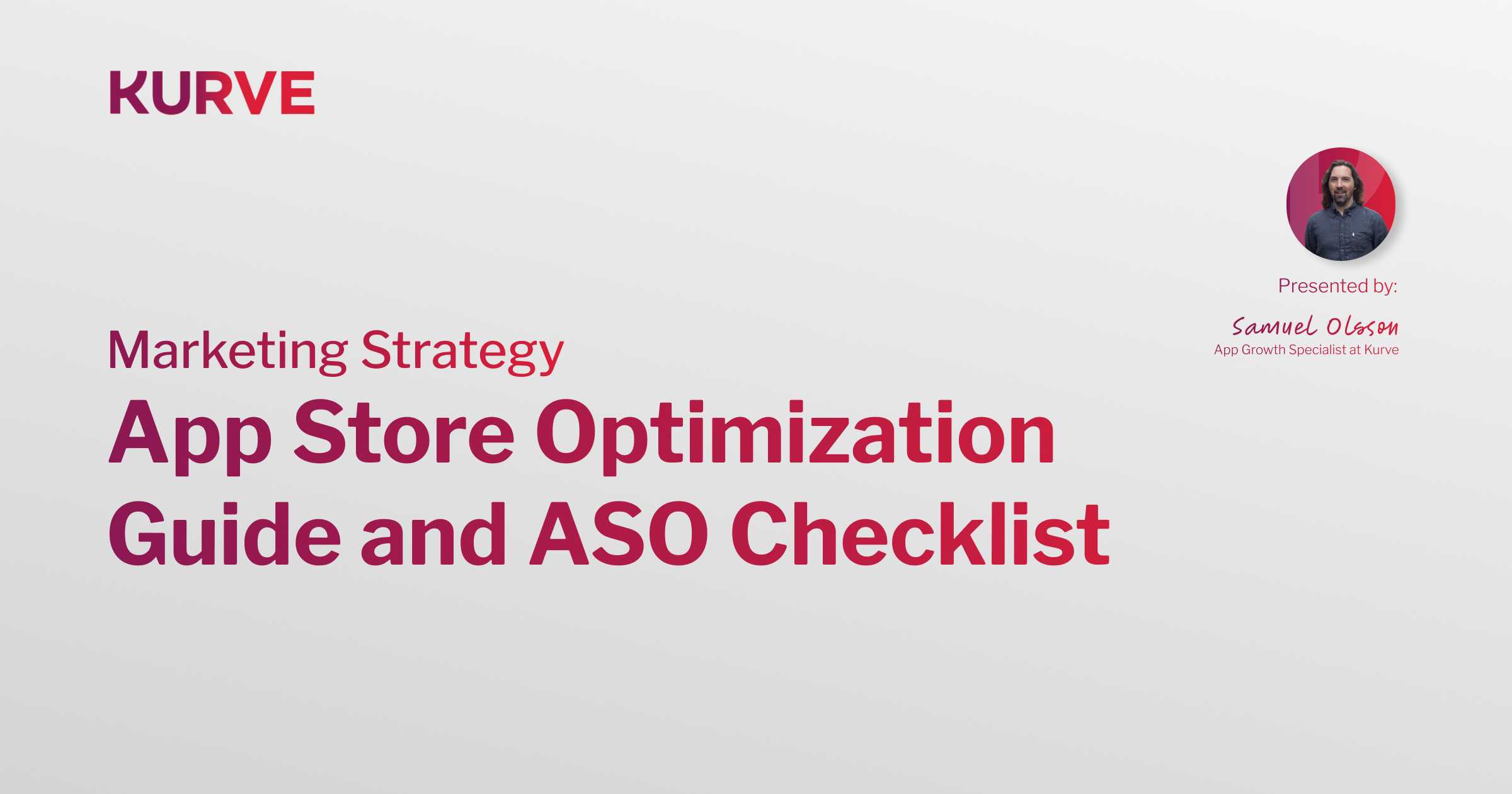Mobile Analytics Guide: Boost Your App's Visibility.
A mobile application is almost a necessity for businesses. But it's more than creating an app for the sake of it; understanding its performance and effectiveness is crucial for sustained growth.
That's where we come in. At Kurve, we designed our Mobile App Marketing Services to boost downloads and help mobile apps make a meaningful impact in the market.
So, what's the key to measuring and enhancing your mobile app's performance? The answer is mobile analytics. It's the linchpin for successful mobile advertising campaigns, helping you understand what's working and what needs improvement.
This comprehensive guide will look deeper into everything you need about mobile analytics. From the fundamental aspects to its role in advertising campaigns, we've got you covered.
What is Mobile Analytics?
Navigating the mobile app landscape demands data-driven strategies. Mobile analytics are your guiding light. They offer a wealth of information on various aspects of your mobile app development.
From user behavior to revenue streams, analytics provide the data needed to make informed decisions. But what exactly can you measure, and how can different analytics help you achieve your specific goals? Let's explore.
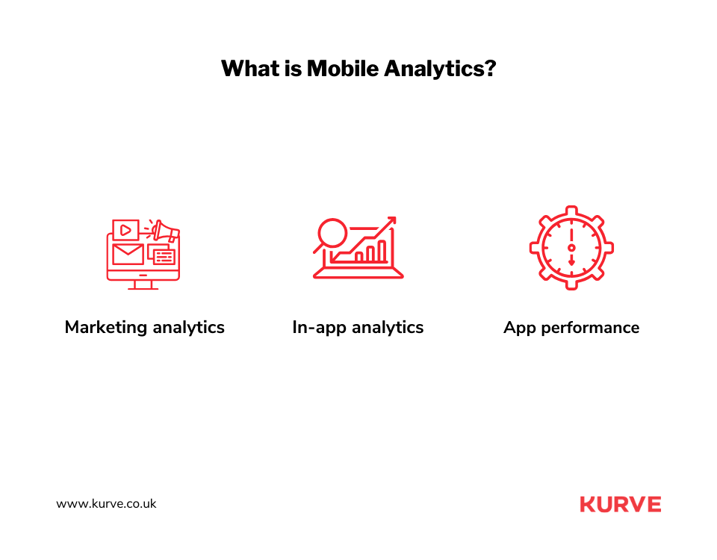
Mobile App Analytics
Mobile App Analytics is indispensable for understanding your mobile app's inner workings. They offer insights into user engagement, revealing how often users open the app and how much time they spend on it.
Additionally, these analytics highlight which features are most popular, helping you identify areas for improvement or expansion. Metrics like retention and churn rates can further inform your growth strategies. Understanding them allows you to fine-tune your user engagement efforts for long-term success.
Mobile Web Analytics
Mobile Web Analytics goes beyond the app. It focuses on user interactions within mobile browsers. These analytics show how users discover your mobile website, be it through organic search, social media, or direct visits.
Understanding user pathways and behavior on your mobile site helps you optimize for conversions. This data is crucial for refining your mobile web strategy and improving user experience.
Mobile Advertising Analytics
If you're running mobile ad campaigns, Mobile Advertising Analytics is the performance metric for you. These analytics can show you the click-through rates for different ads, helping you understand which messages resonate with your audience.
You can also track conversion rates to see how many clicks are turning into actual sales or other desired actions. This level of detail enables you to allocate your advertising budget more effectively, ensuring you reach the most receptive audiences.
App Monetization Analytics
App Monetization Analytics is crucial for apps with in-app purchases or subscription models. These analytics provide a detailed look at your revenue streams, breaking down earnings by user segments, geographic locations, and more.
Understanding the average transaction and user lifetime value can help you tailor your monetization strategies. For example, you might discover that one-time in-app purchases are more popular than subscriptions among certain user groups, allowing you to adjust your offerings.
In-App Engagement Analytics
In-app Engagement Analytics focuses on how users interact with the various features within your app. These analytics show which in-app elements are most engaging, from videos and articles to games and quizzes.
You can better understand what keeps users engaged by tracking metrics like session length and feature usage. This information is invaluable for future feature development and refining existing elements to improve user retention.
Mobile analytics are a comprehensive toolkit for understanding and improving your mobile app's performance. Each type of analytics data offers unique insights that help provide a 360-degree view of your app's health and growth opportunities.
Why Learn Mobile Analytics?
Understanding mobile analytics is more than a luxury; it's necessary for any serious app developer or marketer. The data you collect can serve as the backbone of your growth strategy, offering actionable insights that can impact your app's success.
Firstly, let's talk about relevance. In an ever-competitive mobile app market, staying ahead requires more than a great product; it demands a deep understanding of your users. Mobile analytics offer a granular view of user behavior, engagement levels, etc.
For example, take our work with Sweatcoin. We optimized user acquisition strategies by leveraging mobile analytics and improved in-app engagement. The result? A significant increase in user retention and app performance. Learn more about our work with Sweatcoin.
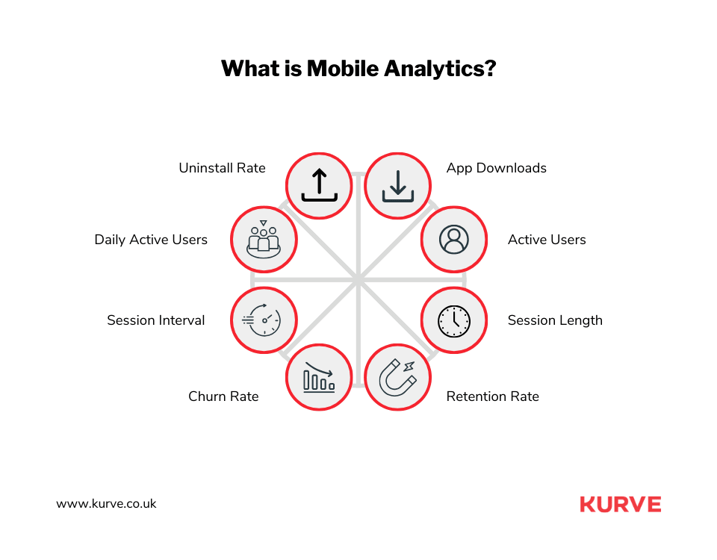
Benefits of Mobile Analytics
- User Behavior Insights: Knowing how users interact with your app can help you make data-driven decisions. Whether it's tweaking an existing feature or introducing a new one, these insights are invaluable.
- Optimized Marketing Campaigns: Mobile analytics allow you to measure the effectiveness of your marketing campaigns. From click-through to conversion rates, you can assess what's working and what needs adjustment.
- Revenue Tracking: Analytics can track app revenue streams with in-app purchases or ads. This data can help you understand which monetization strategies are most effective.
- User Retention: Understanding why users stay or why they leave is crucial. Analytics can provide data on user engagement and activity, helping you implement strategies to improve retention.
- Resource Allocation: You can allocate resources more efficiently with a clear understanding of which features are most used and ignored. This ensures you're investing in areas that will yield the highest returns.
- Competitive Analysis: Mobile analytics can also provide insights into how you stack up against the competition. Knowing where you stand can help you identify opportunities for growth and differentiation.
Mobile analytics have plenty of insights that can guide your growth strategies. From understanding user behavior to optimizing revenue streams, the benefits are manifold. As our work with Sweatcoin demonstrates, the correct use of analytics can be a game-changer in your app's success trajectory.
Common Mobile Analytics Metrics
Navigating the world of mobile analytics can be overwhelming, especially with the plethora of metrics available. This section will demystify the most common metrics you should track. We'll provide actionable tips and best practices to help you optimize each one.
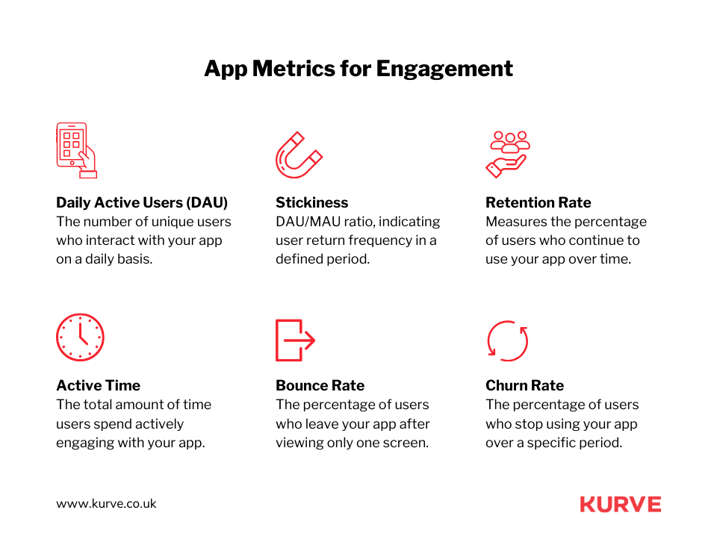
Organic Downloads
Organic downloads are the lifeblood of any successful mobile app. These downloads come without paid advertising, serving as a testament to your app's inherent quality and appeal. A high number of organic downloads often indicates strong brand recognition and trustworthiness.
It's crucial to track trends over time to maximize the benefits of this metric. For example, a sudden uptick in organic downloads could result from a well-executed PR campaign, a viral social media post, or a successful app update. But, a decline could signal issues that need immediate attention.
Focus on App Store Optimization (ASO) and high-quality content marketing to boost this metric. User reviews and ratings are crucial as they influence your app store ranking.
Session Duration and Exploration
Session duration is another critical metric that provides insights into user engagement. It measures a user's time in your app during a single session. The longer the session duration, the higher the chances that the user is finding value in your app.
Yet, session duration shouldn't be the sole focus. Understanding how users navigate your app during these sessions is equally important, a concept known as exploration. Are users dropping off at a specific stage? Are they completing the actions that you've laid out for them? This understanding can help you pinpoint areas that may need improvement.
To enhance this metric, consider adding features that encourage longer sessions. Personalized content or rewards for specific actions can go a long way in achieving this.
Behavioral Screen Flow
Users' path within your app is critical to improving user experience and retention rates. Behavioral screen flow analytics visually represent these paths, helping you understand where users most drop off or spend the most time.
Analyzing this data lets you decide where to place critical features or CTAs to guide users toward desired outcomes.
For instance, if users abandon a particular screen, consider simplifying it or providing more information to keep them engaged.
User Analytics
User analytics is a broad category that encompasses several sub-metrics, each providing a different layer of understanding about your user base.
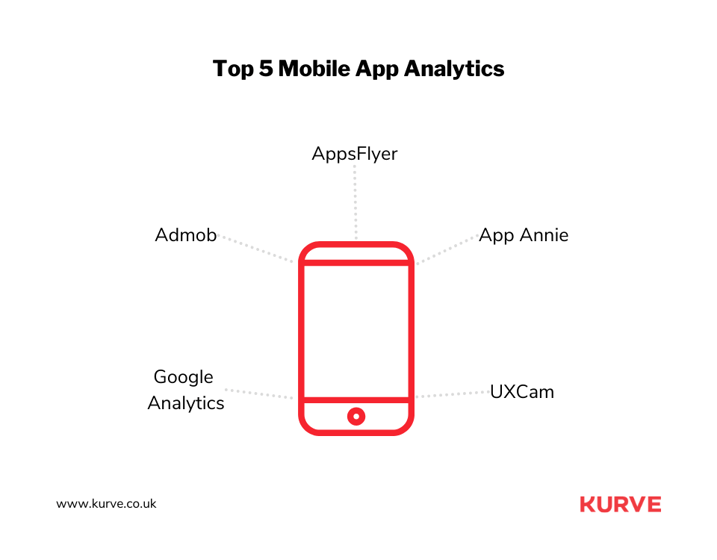
Active Users
Active users engage with your app within a specific time frame, whether daily, weekly, or monthly. This metric is crucial for understanding the health of your app. A high number of active users indicates strong engagement and value delivery, while a decline could signal that users are losing interest.
User Engagement
User engagement metrics provide insights into how users are interacting with your app. Are they completing key actions? Are they returning after their first visit? High engagement levels often correlate with higher retention rates and excellent lifetime value.
Conversion Rate
The conversion rate measures the percentage of users who complete a specific action within your app, such as purchasing or signing up for a newsletter. This metric is crucial for understanding how effectively your app encourages users to take desired actions.
Average Revenue per User (ARPU)
ARPU, or Average Revenue per User, is a financial metric that gives you a snapshot of the revenue generated per active user over a specific period. It's calculated by dividing the total revenue by the number of active users. This metric is vital for gauging the monetary success of your app and understanding your users' value.
To analyze ARPU, segment your user base into new, returning, or high-engagers. This will help you identify which groups are most profitable. A high ARPU is a positive indicator of your app's ability to monetize its user base. A low ARPU could signal missing out on potential revenue streams.
Consider implementing in-app purchases or subscription models to optimize ARPU. Also, personalized marketing can help you better target high-value users.
App Store Optimization (ASO) Metrics
ASO metrics are essential for understanding your app's visibility within app stores. These metrics can include;
- your app's search ranking for specific keywords,
- the click-through rate (CTR) on your app store listing,
- and the conversion rate from your app store listing to download.
Analyzing ASO metrics involves tracking keyword rankings over time and monitoring changes in CTR and conversion rates. A high ranking for relevant keywords and a high CTR are indicators of effective ASO. However, a low conversion rate could mean your app listing needs to be more compelling to prompt downloads.
To improve ASO metrics, focus on keyword optimization and A/B testing different elements of your app store listing, such as screenshots and descriptions.
In-App Events
In-app events are specific actions that users take within your app. An example could be making an in-app purchase, completing a level, or sharing content. Tracking these events provides valuable insights into user behavior and preferences.
To analyze this metric, set up event tracking within your analytics tool. This will allow you to see which events are most triggered and by whom. High-frequency events generally show features that resonate with your users, while low-frequency events may need re-evaluation.
Use this data to inform your app updates and marketing strategies. For instance, if a particular in-app purchase is widespread, consider promoting it more aggressively through targeted campaigns.
Each of these metrics offers a unique perspective on your app's performance. By understanding and optimizing them, you can make informed, data-driven decisions contributing to your app's success.
Mobile Analytics Tools
After exploring the intricacies of mobile analytics, you might wonder, "Which tools can help me put this knowledge into action?" Well, you're in the right place.
This section will look at three industry-leading mobile analytics tools: Amplitude, Flurry, and FullStory. Each offers unique capabilities designed to empower your mobile analytics strategy.
Amplitude
When it comes to a holistic approach to mobile analytics, Amplitude stands out. This platform is not only an analytics tool; it's a comprehensive solution that integrates experimentation, data analysis, and audience targeting.
Why Choose Amplitude?
Amplitude's integrated analytics platform is like a Swiss Army knife for data. Whether running A/B tests or diving deep into audience segmentation, Amplitude has you covered. The platform even connects with your existing data ecosystem, making it easier to consolidate insights.
Caveats to Consider
While Amplitude offers a robust set of features, it's challenging. For instance, you'll need to manage cookie settings to get the most out of the platform. And if you're new to analytics, the sheer range of features might feel overwhelming.
What Else Should You Know?
Amplitude offers a free trial, giving you a risk-free opportunity to explore its capabilities. It is also a superior alternative to GA4, especially for in-depth marketing insights.
Flurry
If longevity in the industry is a sign of reliability, Flurry is a name you can trust. Operating since 2008, Flurry focuses on supercharging app engagement and facilitating data-driven product development.
Why Choose Flurry?
Flurry's custom dashboards are a godsend for busy professionals. You can glance at your critical metrics without sifting through endless reports. And the best part? It's free to use, making it accessible for startups and established businesses alike.
Caveats to Consider
While being free is an advantage, it comes with its own set of limitations. There's no contractual commitment, so if you're looking for guaranteed service levels, something other than this might be your tool. Also, be prepared to manage cookies for optimal functionality.
What Else Should You Know?
Flurry offers a lightweight SDK that takes less than five minutes to integrate. Plus, you can export your data for custom analysis, giving you complete control over your insights.
FullStory
For those who focus on user experience, above all else, FullStory is the tool to consider. It offers a 360-degree view of user interactions, making it easier to identify bottlenecks and opportunities for improvement.
Why Choose FullStory?
FullStory's proprietary Autocapture technology is like having a CCTV camera for your app. It monitors every interaction, helping you identify and prioritize areas for improvement. Plus, it integrates with other tools your team might already use.
Caveats to Consider
Like other platforms, FullStory requires users to consent to cookies for the best experience. And its wide array of features might be a bit much for those new to the analytics game.
What Else Should You Know?
FullStory has garnered positive reviews on platforms like G2 and TrustRadius. It also emphasizes that you own your data, allowing you to take it with you if you switch platforms.
Each tool has unique features and limitations tailored to different needs and expertise levels. By understanding what each tool excels at, you can make an informed decision that aligns with your mobile analytics objectives.
Elevate Your Mobile App’s Performance
Navigating the mobile app world is complex, but it doesn’t have to be a guessing game. Mobile analytics are your roadmap to understanding user behavior, optimizing engagement, and boosting revenue. The insights are invaluable for making data-driven decisions that propel your app to success.
But analytics are only one piece of the puzzle. To excel, you need a partner who understands the nuances of mobile app marketing. That's where Kurve comes in. Our expert-led services offer a holistic approach to mobile app growth, from strategy to execution.
Ready to elevate your mobile app's performance? We designed Kurve's Mobile App Marketing Services to help you achieve that. Let us be your guide to achieving measurable and sustainable growth.

